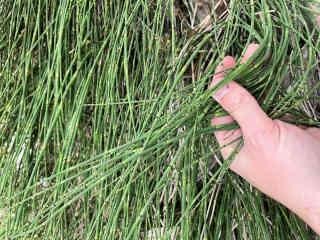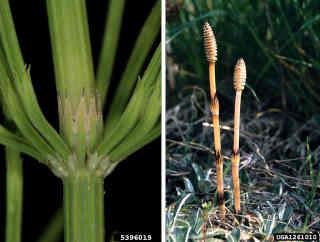By Sarah Lancaster
Extension Weed Science Specialist, Sarah Lancaster, recently received a photo of an unknown weed that is nearly impossible to control with herbicides (Figure 1). The weed is an Equisetum species, also known as horsetails. Two Equisetum species in Kansas are field horsetail (E. arvense) and scouring rush (E. hyemale). These are prehistoric plants that can be found in the fossil record before dinosaurs. So, it’s not surprising that they are pretty resilient!

Figure 1. Photo of an Equisetum species (likely scouring rush) submitted for identification.
Ecology
Horsetails are generally found in moist soils, such as those found in forests, ditches, or the margins of water bodies. It can grow in either sunny or shaded sites. They contain high concentrations of silica, which made them useful to Native Americans for polishing or scouring. Scouring rush was also used as a drinking straw. Because of the chemical composition, stems typically stand for more than one year. Horsetails have a neurotoxin that can harm livestock, but animals will rarely graze them unless harvested as hay or during winter.
Identification
Horsetails have upright, round, evergreen stems that emerge from rhizomes to form dense stands. Tubers are also found in the field horsetail's root system and sometimes on scouring rush. Stems can be from 7 inches to over 6.5 feet tall with vertical ridges (silica deposits). Dark, toothed bands form at the nodes. The stems of both horsetail species are hollow, with a larger cavity (about ¾ of the stem diameter) in scouring rush. Field horsetail has two types of stems. Sterile stems have whorled branches, while fertile stems have neither branches nor chlorophyll (Figure 2).

Source : ksu.edu